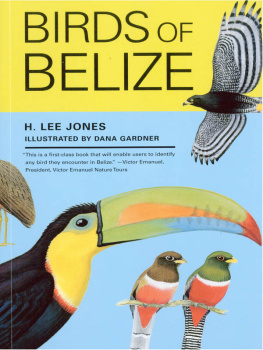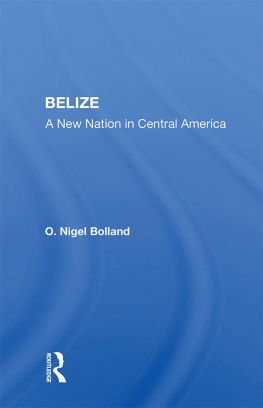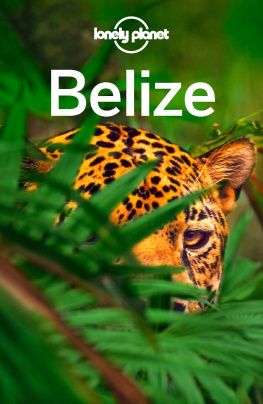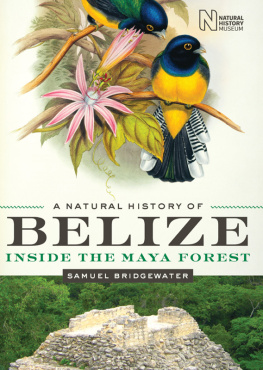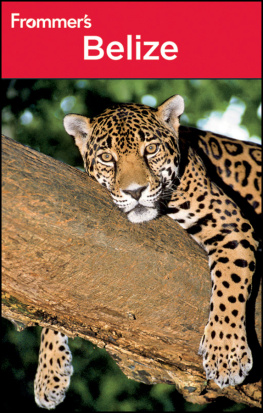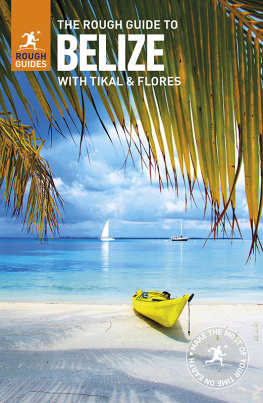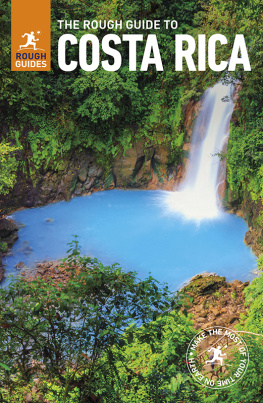Gardner Dana - Birds of Belize
Here you can read online Gardner Dana - Birds of Belize full text of the book (entire story) in english for free. Download pdf and epub, get meaning, cover and reviews about this ebook. City: Austin;TX;Belize, year: 2004, publisher: University of Texas Press, genre: Romance novel. Description of the work, (preface) as well as reviews are available. Best literature library LitArk.com created for fans of good reading and offers a wide selection of genres:
Romance novel
Science fiction
Adventure
Detective
Science
History
Home and family
Prose
Art
Politics
Computer
Non-fiction
Religion
Business
Children
Humor
Choose a favorite category and find really read worthwhile books. Enjoy immersion in the world of imagination, feel the emotions of the characters or learn something new for yourself, make an fascinating discovery.
- Book:Birds of Belize
- Author:
- Publisher:University of Texas Press
- Genre:
- Year:2004
- City:Austin;TX;Belize
- Rating:4 / 5
- Favourites:Add to favourites
- Your mark:
- 80
- 1
- 2
- 3
- 4
- 5
Birds of Belize: summary, description and annotation
We offer to read an annotation, description, summary or preface (depends on what the author of the book "Birds of Belize" wrote himself). If you haven't found the necessary information about the book — write in the comments, we will try to find it.
Birds of Belize provides the first complete guide to the identification of all currently known species574 in all.
Birds of Belize — read online for free the complete book (whole text) full work
Below is the text of the book, divided by pages. System saving the place of the last page read, allows you to conveniently read the book "Birds of Belize" online for free, without having to search again every time where you left off. Put a bookmark, and you can go to the page where you finished reading at any time.
Font size:
Interval:
Bookmark:
THE CORRIE HERRING HOOKS SERIES
NUMBER FIFTY-SEVEN
H. Lee Jones
Illustrated by Dana Gardner
 University of Texas Press, Austin
University of Texas Press, Austin
Copyright 2003 by H. Lee Jones
Illustrations 2003 by Dana Gardner
All rights reserved
Printed in China
Third paperback printing, 2010
Requests for permission to reproduce material from this work should be sent to:
Permissions
University of Texas Press
P.O. Box 7819
Austin, TX 78713-7819
www.utexas.edu/utpress/about/bpermission.html
 The paper used in this book meets the minimum requirements of ANSI/NISO Z39.48-1992 (R1997) (Permanence of Paper).
The paper used in this book meets the minimum requirements of ANSI/NISO Z39.48-1992 (R1997) (Permanence of Paper).
Library of Congress Cataloging-in-Publication Data
Jones, H. Lee.
Birds of Belize / by H. Lee Jones ; illustrated by Dana Gardner.
p. cm. (The Corrie Herring Hooks series ; no. 57)
Includes bibliographical references and index.
ISBN 978-0-292-74066-2 (cl. : alk. paper)
ISBN 978-0-292-70164-9 (pbk. : alk. paper)
ISBN 978-0-292-79245-6 (individual e-book)
1. BirdsBelizeIdentification. 2. BirdsBelize
Pictorial works.
I. Gardner, Dana. II. Title. III. Series.
QL687 .B45 J66 2004
598.097282dc21
2003010956
Without the pioneering work of Steve Howell and Sophie Webb, this book would not have been possible. The publication in 1995 of their book A Guide to the Birds of Mexico and Northern Central America immediately elevated birding in Belize to a higher plane. Previously, the only publications on Belize birds were Steve Russells Distributional Study of the Birds of British Honduras (1964), which was long out of date and nearly impossible to find, and several equally out-of-date checklists. John Moores excellent A Bird Walk at Chan Chich audiotape was produced around the same time I arrived in Belize in 1992 and became my constant field companion. Ultimately, I was able to resolve the myriad jungle sounds by listening to Moores tape over and over and over again.
I obtained much additional valuable information from the published literature and numerous unpublished documents and newsletters. These are cited in the references section at the end of the book. But, without doubt, the bulk of information on the status and seasonality of birds in Belize has come from the unpublished field notes and verbal and e-mail communications received from a growing network of birders in Belize. I am especially indebted to Philip Baldera-mos, Jim and Dorothy Beveridge, Steve Howell, Susan Lala, Ellen McRae, Martin Meadows, and Nick Smith for generously providing me with their excellent field notes. Many others have provided their trip reports and noteworthy sightings. These included Tim Brush, Rudi Burgos, John and Agnes Caulfield, Micky Craig, Glenn Crawford, Thomas Donegan, Marcus England, Omar Figueroa, John Gilardi, Alvaro Jaramillo, Andy Johnson, Jacques Laesser, Mark and Karen MacReynolds, Jan Meerman, Mario Muschamp, Wilfred Requena, Paul Rodewald, John Row-lett, Chris Sharpe, Mary Beth Stowe, Sam Tillett, Jonathan Urbina, Andrew Vallely, and Barry Zimmer.
Van Remsen, Steve Cardiff, and Donna Dittmann (Louisiana State University Museum of Natural Science), Kimball Garrett (Los Angeles County Museum of Natural History), Manuel Marin (Western Foundation for Vertebrate Zoology), Peter Capainolo (American Museum of Natural History), Steve Howell (Point Reyes Bird Observatory), Bruce and Carolyn Miller (Wildlife Conservation Society), Jon Dunn, and numerous members of the NEOORN listserv have helped in many other ways by providing access to specimens, tracking down obscure documents, providing vital information on unpublished records, or lending their expertise in helping to resolve any of a number of sticky identification issues. I would especially like to thank Kimball Garrett for his meticulous scrutiny of and thoughtful comments on the draft manuscript.
The knowledge and assistance of Amos Capps and Betsy Mallory in developing the range maps, and Capps in creating a database of bird observations, were invaluable. Early on, Bob Ridgely generously donated his personal copy of the hard-to-find Distributional Study of the Birds of British Honduras. Sharon Matola and Conservation International were instrumental in arranging for both Dana Gardner and myself to participate in a two-week expedition into the Maya Mountains to explore the little-known flora and fauna of that region. William (Chet) Schmidt provided assistance early in the project in introducing me to a number of unexplored areas of southern Belize. The Belize Audubon Society provided transportation to Half Moon Caye and unlimited access to its library. The inclusion of local Creole, Kekchi, and Mopan Maya names in the Other Names section of the species accounts was made possible largely through the efforts of Sam Tillett (Creole names), Marcus Ack and Carol Smith (Kekchi names), and Juan Chun, Juan Sho, Sylvano Sho, and Victor Sho (Mopan Maya names).
During the 10 years I have been living part-time in Belize, I have received generous support and encouragement from many sources. Jim and Dorothy Beveridge, Mark and Monique Howells, Susan and Wil Lala, Matthew and Marga Miller, Tina and Kirby Salisbury, and Sam and Rita Tillett have at one time or another provided excellent accommodations and an endless supply of hospitality and friendship during my frequent travels around the country. Several nongovernmental organizations such as TIDE, PLENTY Belize, and the Toledo Ecotourism Association have generously provided logistical support and field assistance whenever called upon.
Special thanks are due to Philip Balderamos, Brian Holland and Anne Brorsen, Martin Meadows, and Larry Munsey for their support and encouragement throughout the project and to Len Zeoli and Wilfred Requena for their near constant companionship and support in the field during the last year of the project. Jacquie Stricklind managed my stateside affairs during my lengthy absences. Without her support, I could not have devoted anywhere near the time I did to fieldwork in Belize.
Finally, the still small but ever growing army of Belizean birders is adding exponentially to our knowledge of Belizes remarkable avifauna. More than anyone else, this book is dedicated to them. It is hoped that they will find this book a source of information and encouragement in their pursuits and will use it to extend and improve our knowledge still further.
BE = Belize District
CA = Cayo District
CO = Corozal District
OW = Orange Walk District
SC = Stann Creek District
TO = Toledo District
Afr. = Africa
Aust. = Australia
Can. = Canada
C.A. = Central America
C.R. = Costa Rica
E.S. = El Salvador
Eur. = Europe
Guat. = Guatemala
Hon. = Honduras
Mex. = Mexico
N.Z. = New Zealand
Nic. = Nicaragua
N.A. = North America
Pan. = Panama
S.A. = South America
U.S. = United States
W.I. = West Indies
The modifiers n (northern), s (southern), e (eastern), w (western), c (central), ne (northeastern), and so on are used with the above geographical entities to indicate the specific portion of the region referred to (for example: c TO = central Toledo District; nw S.A. = northwestern S.A.).
These same symbols are used with a period to denote compass direction: n., s., e., w., n.e., and so on.
Font size:
Interval:
Bookmark:
Similar books «Birds of Belize»
Look at similar books to Birds of Belize. We have selected literature similar in name and meaning in the hope of providing readers with more options to find new, interesting, not yet read works.
Discussion, reviews of the book Birds of Belize and just readers' own opinions. Leave your comments, write what you think about the work, its meaning or the main characters. Specify what exactly you liked and what you didn't like, and why you think so.

